Every year the village of Bievres plays host to an International Photo Fair. One of my students strongly suggested a visit would be required.

On Saturday morning we awoke to the sound of rain. This on a day that supposedly had zero percent chance of the Wet Stuff. There was nothing to do but gird the loins, leave the sun hat at home, and set off.
On arriving at the station, the Weather Gods had figured we'd had enough dampness for one day and the Bright Yellow Orb shown down bright and surprisingly hot. The fair is held up the hill from the RER C Bievres drop-off-point. The hilly center of the village is given over to the fair. Simply following the crowds led me to a narrow lane filled with vendors of old and ancient appareil photo.
When we lived in the States I sometimes manned a table at our local photo-swaps. So it was with great interest that wandered the aisles to see what the Europeans had on offer.
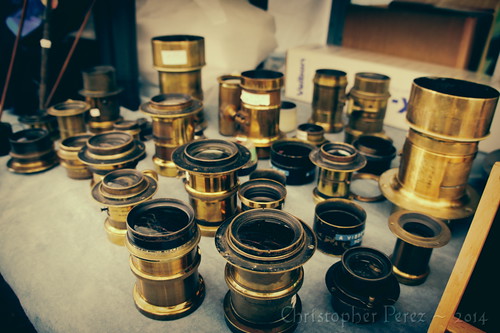
The advertising suggests the event is international. A quick listen to who was saying what revealed that in addition to the expected French vendeur there were tables and booths strongly manned by Swedes, Italians, Germans (my gawd! yet another invasion?), and British (oh good lawd! how did so many get here? are the maps these days that accurate??).
What was on offer Blew My Little Mind. Brass Lenses. Stacks and stacks of Brass Lenses. Lenses the likes of which some photographers might believe would add "something special" to their images. Bit Brass Lenses. Little Brass Lenses. Convertable Brass Lenses. A Brass Lens to Fit Any Size. Most were ground by Parisian Opticien. Some by the English. Gawds! If only I were a wet plate collodion practitioner...
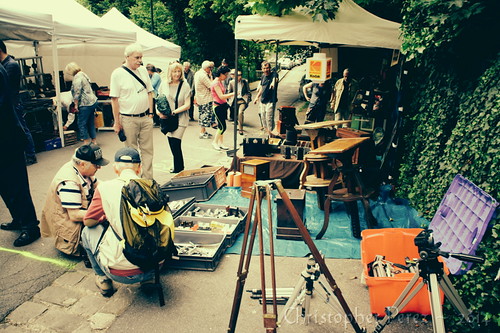
... and if I were interested in ether and egg-whites, there were a great many chambre to choose from. I saw everything from fairly recent Linhof 4x5 rail cameras all the way back to ancient and sometimes Very Large format wood photographic tools. Many of the oldest cameras came with holders ready to take your hand-coated glass plates.
Then there were the several Canon 7 rangefinder cameras avec f/0.95 lentille. I'd only ever see one of these In The Wild. Now I saw three. In one day. Putting that Chuck of Glass on a mirrorless body would dwarf the poor thing.
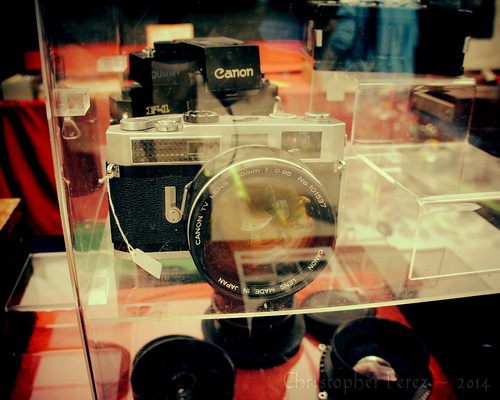
I was surprised by the shear volume of Nikon film-era gear. Camera bodies. Lenses. My my! the lenses. Some in perfect condition. Much in a Well Worn State. I spied a pretty Ais 28mm f/2 and a late Ai 85mm f/1.8 K in mint condition sitting amoungst absolute junk.
Similarly, the Germans and (to me rather surprisingly) the Italians laid out a feast of Leica equipment. Yes, there was the expected rangefinder gear (bodies and lenses) good and great. Yet there was a fair amount of "R"-series SLR stuff, too. If I were susceptible to such things, there were more than a few tasty R-glass optics to be had.
As I wandered the aisles I couldn't help but notice that not much was selling. Not the big ticket items at least. So I visited as many tables as I could to get a sense of why this might be. Well, one answer was immediately at hand. Price. With only two exceptions, I found people pricing their gear over the top end of What the Market Would Tolerate.
Here are a few examples, and don't forget to multiply these prices in Euro by 1.36-ish to get the actual costs in USD.

Well used Nikkor 50mm f/1.2 for 375Euro. Ancient Saphire Paris LF lens (I'm not convinced it was a complete optic) for 1000Euro. Three Canon 50mm f/1.8 EOS with non-working AF for 79Euro each. Canon 50mm f/1.4 EOS for 290Euro. Linhof Kardan 4x5 for 1200Euro, and this thing was thrashed. Pentax Takumar 85mm f/1.9 (you know the one) for 250Euro, and this too was completely knackered. Leica M-bodies in battered condition started at 800Euro and jumped into the stratosphere from there as condition improved.
I met Dan The Man From WICE and his girlfriend on the lower lane of the swap. I was reminded by Dan's Parisienne friend that "... in France, one must barter. It's expected..." Considering that she might be right, I went back to the table with the EOS 50 f/1.4 on it to see if I could get a better price quoted. On arrival I found the lens mounted on a little Japanese woman's Canon. As she played with it, taking photos of nothing and everything, she asked if he'd take 270Euro for it. His immediate replay was "Non!" So much for that idea.
The two tables where things were reasonably priced against current market expectations (using eBay as just one source of comparison) not much was moving there either. One guy had a nice collection of 8 or 9 condition Nikkor manual focus lenses. I was sorely tempted by his 50Euro 100mm f/2.8 E, 50Euro mint 50mm f/1.4, 100Euro mint 85mm f/2 Ais, and 50Euro gorgeous 28mm f/2.8 Ai. Since I already have many of these, why duplicate things with more glass I'd never use? Still, what struck me was that these wonderful optics were still sitting on the man's table unsold.
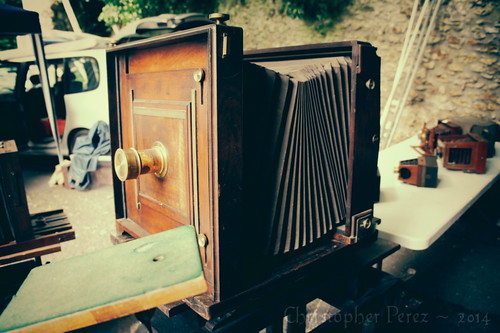
So perhaps the lack of sales wasn't just about price?
On my way out I walked the aisle dedicated to old and ancient photographic images. Tin plates. Albumin. Platinum/palladium. Early silver. All manner of subject, too. Travel. Studio portraits. Street scenes. As I picked through a few stacks of images I was reminded of the Real end product of the photographic endeavor could be.
On reflection I'm curious as to why there were so few images compared to the Boat Loads of cameras and lenses. Maybe it has something to do with how people feel the creative spirit is activated? You should've heard the conversation in French/English between a Japanese visitor who's black mint condition Leica M4 sported an early chrome Leitz lens of some kind or other. The Frenchman went nuts as he recognized it as being something Incredibly Rare. After-all, if you have Just the Right Lens and the Perfect Camera, maybe you too will make a fabulous photo?
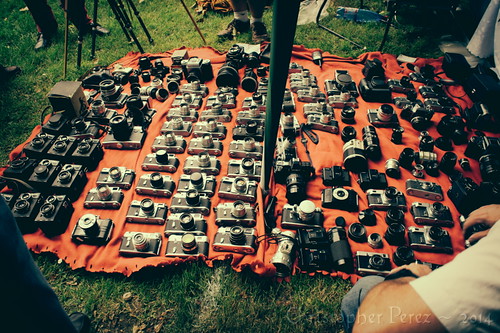
Riding the RER C back to Versailles-Chantier to jump the next N-line back into Monstparnasse Bienvenu I couldn't shake the feelings I had for a photograph I saw. It was, perhaps, 6.5x8.5inches in size and printed on heavy double weight paper. It was of a nude from behind. The print was obviously late 19th or very early 20th century. The blacks were not clinically black, nor were the whites brilliantly white like modern works might strive to (easily, these days) achieve. No, this image had a subtlety of illumination, composition, and tonal range that really appealed to me. The light, ah the light, seemed to drip, slide, and ooze down the model's body. Wasn't this what photography was about, making a fabulous image?
That one single beautiful print was the Very Best Thing I saw all day.

... sitting proudly on a tall tripod, welcoming guests to the show...
On Saturday morning we awoke to the sound of rain. This on a day that supposedly had zero percent chance of the Wet Stuff. There was nothing to do but gird the loins, leave the sun hat at home, and set off.
On arriving at the station, the Weather Gods had figured we'd had enough dampness for one day and the Bright Yellow Orb shown down bright and surprisingly hot. The fair is held up the hill from the RER C Bievres drop-off-point. The hilly center of the village is given over to the fair. Simply following the crowds led me to a narrow lane filled with vendors of old and ancient appareil photo.
When we lived in the States I sometimes manned a table at our local photo-swaps. So it was with great interest that wandered the aisles to see what the Europeans had on offer.

Brass lenses of several designs -
Objects of Serious Desire of former times, these
The advertising suggests the event is international. A quick listen to who was saying what revealed that in addition to the expected French vendeur there were tables and booths strongly manned by Swedes, Italians, Germans (my gawd! yet another invasion?), and British (oh good lawd! how did so many get here? are the maps these days that accurate??).
What was on offer Blew My Little Mind. Brass Lenses. Stacks and stacks of Brass Lenses. Lenses the likes of which some photographers might believe would add "something special" to their images. Bit Brass Lenses. Little Brass Lenses. Convertable Brass Lenses. A Brass Lens to Fit Any Size. Most were ground by Parisian Opticien. Some by the English. Gawds! If only I were a wet plate collodion practitioner...

... oh, so much to pick through... looking for...
well... what, exactly?... what do we need today?...
... and if I were interested in ether and egg-whites, there were a great many chambre to choose from. I saw everything from fairly recent Linhof 4x5 rail cameras all the way back to ancient and sometimes Very Large format wood photographic tools. Many of the oldest cameras came with holders ready to take your hand-coated glass plates.
Then there were the several Canon 7 rangefinder cameras avec f/0.95 lentille. I'd only ever see one of these In The Wild. Now I saw three. In one day. Putting that Chuck of Glass on a mirrorless body would dwarf the poor thing.

How many of these Rare Beasts can on show offer?
This one was listed at 1900Euro.
I was surprised by the shear volume of Nikon film-era gear. Camera bodies. Lenses. My my! the lenses. Some in perfect condition. Much in a Well Worn State. I spied a pretty Ais 28mm f/2 and a late Ai 85mm f/1.8 K in mint condition sitting amoungst absolute junk.
Similarly, the Germans and (to me rather surprisingly) the Italians laid out a feast of Leica equipment. Yes, there was the expected rangefinder gear (bodies and lenses) good and great. Yet there was a fair amount of "R"-series SLR stuff, too. If I were susceptible to such things, there were more than a few tasty R-glass optics to be had.
As I wandered the aisles I couldn't help but notice that not much was selling. Not the big ticket items at least. So I visited as many tables as I could to get a sense of why this might be. Well, one answer was immediately at hand. Price. With only two exceptions, I found people pricing their gear over the top end of What the Market Would Tolerate.
Here are a few examples, and don't forget to multiply these prices in Euro by 1.36-ish to get the actual costs in USD.

...just a few of the many steeply priced lenses
to be seen at the show...
Well used Nikkor 50mm f/1.2 for 375Euro. Ancient Saphire Paris LF lens (I'm not convinced it was a complete optic) for 1000Euro. Three Canon 50mm f/1.8 EOS with non-working AF for 79Euro each. Canon 50mm f/1.4 EOS for 290Euro. Linhof Kardan 4x5 for 1200Euro, and this thing was thrashed. Pentax Takumar 85mm f/1.9 (you know the one) for 250Euro, and this too was completely knackered. Leica M-bodies in battered condition started at 800Euro and jumped into the stratosphere from there as condition improved.
I met Dan The Man From WICE and his girlfriend on the lower lane of the swap. I was reminded by Dan's Parisienne friend that "... in France, one must barter. It's expected..." Considering that she might be right, I went back to the table with the EOS 50 f/1.4 on it to see if I could get a better price quoted. On arrival I found the lens mounted on a little Japanese woman's Canon. As she played with it, taking photos of nothing and everything, she asked if he'd take 270Euro for it. His immediate replay was "Non!" So much for that idea.
The two tables where things were reasonably priced against current market expectations (using eBay as just one source of comparison) not much was moving there either. One guy had a nice collection of 8 or 9 condition Nikkor manual focus lenses. I was sorely tempted by his 50Euro 100mm f/2.8 E, 50Euro mint 50mm f/1.4, 100Euro mint 85mm f/2 Ais, and 50Euro gorgeous 28mm f/2.8 Ai. Since I already have many of these, why duplicate things with more glass I'd never use? Still, what struck me was that these wonderful optics were still sitting on the man's table unsold.

... there is simply no way to haul this home on the RER...
no way... really... there isn't... OK?...
So perhaps the lack of sales wasn't just about price?
On my way out I walked the aisle dedicated to old and ancient photographic images. Tin plates. Albumin. Platinum/palladium. Early silver. All manner of subject, too. Travel. Studio portraits. Street scenes. As I picked through a few stacks of images I was reminded of the Real end product of the photographic endeavor could be.
On reflection I'm curious as to why there were so few images compared to the Boat Loads of cameras and lenses. Maybe it has something to do with how people feel the creative spirit is activated? You should've heard the conversation in French/English between a Japanese visitor who's black mint condition Leica M4 sported an early chrome Leitz lens of some kind or other. The Frenchman went nuts as he recognized it as being something Incredibly Rare. After-all, if you have Just the Right Lens and the Perfect Camera, maybe you too will make a fabulous photo?

... a table? Who needs a table when a blanket a wee-bit-o-open- lawn will do...?
Riding the RER C back to Versailles-Chantier to jump the next N-line back into Monstparnasse Bienvenu I couldn't shake the feelings I had for a photograph I saw. It was, perhaps, 6.5x8.5inches in size and printed on heavy double weight paper. It was of a nude from behind. The print was obviously late 19th or very early 20th century. The blacks were not clinically black, nor were the whites brilliantly white like modern works might strive to (easily, these days) achieve. No, this image had a subtlety of illumination, composition, and tonal range that really appealed to me. The light, ah the light, seemed to drip, slide, and ooze down the model's body. Wasn't this what photography was about, making a fabulous image?
That one single beautiful print was the Very Best Thing I saw all day.
No comments:
Post a Comment